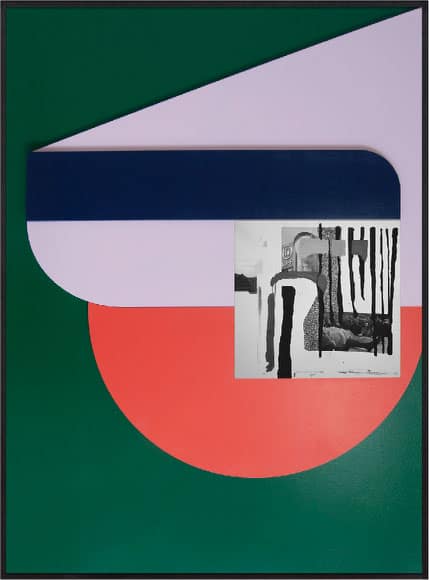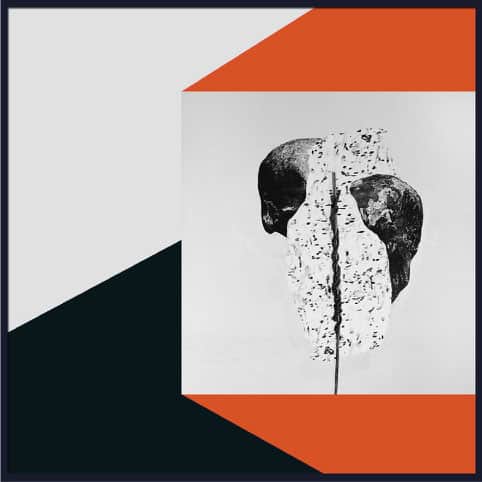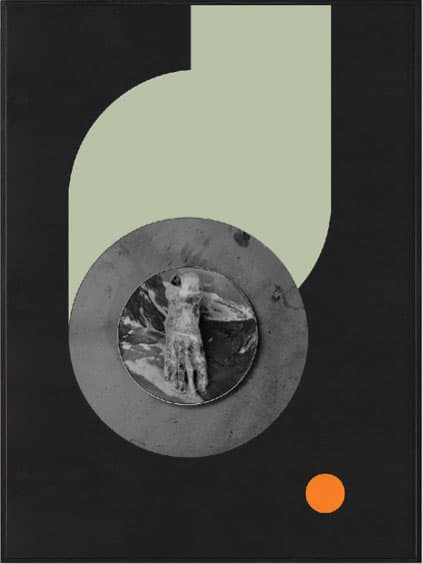“From the sacred centre of the world streams forth an irrepressible desire to overcome the silence between things.
Art, the ever flowing fountain, reveals the secret of life through word and gesture, colour and sound.“
― Hermann Hesse, The Seasons of the Soul
For his Monomyth series begun in 2015, Filip Berendt combines black and white photographs and geometric blocks of colour to create highly charged works depicting a personal and mythological journey. He reprises a process used in a previous body of work whereby he photographs (and then destroys) spatial compositions assembled on the wall of his studio. The resulting images reflect a background in sculpture, graphics, painting and photographic practice.
As the title suggests, this new series conjures up the monomyth, or myth of the Hero – an anthropological figure established by American author and theorist Joseph Campbell through his work in comparative mythology. Campbell’s influential book The Hero With a Thousand Faces (1949) delineated what he termed the “hero’s journey”, a universal narrative pattern which forms nearly every culture’s mythical framework. The hero embarks upon a ritualistic quest of adventure and personal psychological development – a trajectory that unites all the most important primordial tales in human history.
The three main stages, or rites of passage, in any hero’s journey are departure (or ‘separation’), initiation, and return. Through a series of twelve challenging transformative thresholds (all vicissitudes leading up to the final test/ordeal that results in a cathartic rapture) heroes bring new ways of seeing and being that nourish their cultures of origin, whilst undergoing a profound inner change and transition of the self (akin to the Greek hero Odysseus). Monomythical heroes include deities such as Christ, Buddha, or Muhammad alongside mythical figures such as Osiris, Prometheus and Moses. Campbell borrowed the term from a passage in Finnegan’s Wake by James Joyce to define the synthesis of mythology and belief that unify human experience and stories across time, culture, religion and continents. His thinking also parallels the Jungian psychology of archetypes – constantly repeating characters or energies, which can be said to occur in the collective unconsciousness (“myths are public dreams, dreams are private myths”).
Berendt’s impulse (personal and artistic) towards uncovering the heart of the (mono)myth resulted from direct experience of using ayahuasca, a natural hallucinogen. This psychedelic plant-based infusion originated in the Amazon and was initially used for a ritual of solitary (shamanic) transition into the unknown in order to contact the spirit world and bring knowledge back to the tribe. Nowadays, users are encouraged to set ‘an intention’ when physically, mentally, and spiritually preparing for the ayahuasca journey. Berendt experimented with the substance purposefully over nearly two years in a variety of locations worldwide as a way to help reach the myths buried in our subconscious – his prime aim to encounter the classic monomyth as described by Campbell. Such an act of placing himself in an intentional and sacred space in search of being at one with the universe has a long artistic legacy (Witkacy, Polish modernist polymath who used a variety of psychoactive substances such as peyote, cocaine or hashish as a catalyst for creative process, seems apposite here). The immersion in mysticism, or quest to the ‘journey within’ (Romain Rolland), derives from a deep interest in a spiritual realm beyond the phenomenological worldview.
Through his own explorations of ayahuasca, Berendt embarked on a research expedition of sorts that produced works acting as an intuitive documentation of that research through the process of fabrication and re-membering, rather than plain depictions of delirious states resulting from drinking the plant brew. With the aid of the drug and through the self-perpetuated, neo-shamanic process (performance) of self transcendence, Berendt emerged from his clairvoyant trip bringing back artworks of personal discovery and universal appeal: complex accounts of his visions. The Monomyth series bridges the separatedness of an inner world as experienced by the individual hero (the artist), with the desire for understanding human existence and its collective spirit.
The figure of the Shaman – at once magician and medicine man, healer, priest, and poet (as described in the classical study of Mircea Eliade) is particularly relevant here. An artist can be seen as a contemporary embodiment of an ancient mystic inhabiting different eras, cultures, and costumes. This has a long tradition, in modern times perhaps most famously embodied by Joseph Beuys with his personal(-ised) myth and use of raw materials such as wax, felt, fat and coyote. Echoing the lineage of such cultural, mythological or religious ancestors, Berendt works could be read as both the effect and a record/memory of an artistic and spiritual endeavour. They contain visual traces of a transgressive experience, a crossing over to the totality of our individual and mutual psyche: collaged photographs, painterly gestures, colour harmonies and dissonances – fragmented, hallucinatory, semi-erotic and violent high and low cross-cultural and multi-source evocations, dislocated and strangely familiar at the same time. The works generate a strong sense of specific (if rather tenebrous) visual, and philosophical and cultural déjà vu – a common thread in all people that links us all together. They can also stand in as visual vehicles of return to a more mythical (profane) age (as in Eliade’s concept of ‘eternal return’) and act against the secular capitalism and consumer culture of the present-day Western hegemony.
Through the dynamic interplay between the found photographs and appropriated imagery and abstract planes of vivid colour in geometric arrangements, the artist digs deep into shared cultural repositories and renders them (in)visible whilst archiving the outcomes of his personal hero’s journey. The resulting dialectic of the non-representational and the figurative generates a site where understanding (intellect) and sixth sense collide, and impermanence and fluidity prevail. Deliberate usage of black-and-white photographs harks back to the medium’s history and suggests a distant temporality, further indicating the mnemonic, flashback nature of the drug-induced trip and its disjointed retrospective narrative. Occasionally, the artist forsakes the surfaces of pure colour instead moving his hand freely and applying paint directly onto walls. His studio space becomes a prehistoric cave, him acting as if a Paleolithic shaman recording an image of his ecstatic visions on rocks or trees. Once the trance is captured, Berendt’s takes the final picture and obliterates the structure on the wall – the photograph becomes the only evidence, or relic of his secret ceremonies: the artistic and metaphysical excavations.
Highlighting the complexities of the monomyth and collapsing its many layers and dimensions, Berendt has created a peculiar and uncanny portrayal of self-examination: an intuitive expression of the inner journey in search of the importance and power of the myth, and for, in Campbell’s words, “an experience of being alive”.
Written by: Dominik Czechowski
Filip Berendt
Born in 1975, Filip Berendt lives and works in Warsaw, Poland. Combining black and white photographs and geometric blocks of colour, Monomyth sees Berendt create a series of highly charged works depicting a personal and mythological journey. In mythology, the monomyth, or ‘the hero’s journey,’ is the common template of a category of tales, which involve a hero who embarks on an adventure or ritualistic quest for personal development. In a decisive crisis, the hero wins a victory and returns home changed or transformed. Assembling photographic and personal remnants from his recent experiences in South America, on the wall of his studio, Berendt photographs (and then destroys) these spatial compositions. The resulting images combine the artist’s background in sculpture, graphics, painting and photography. They illustrate the fragmentary, fictional nature of memories and memoirs, depicting self-told stories of personal growth and adventure.










